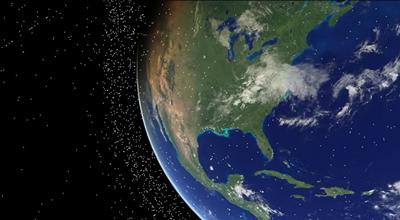
Current levels of space activity may not be sustainable, even without the introduction of so-called ‘mega-constellations’, a new study from the University of Southampton has shown.
Professor Hugh Lewis will tell delegates at the first International Orbital Debris Conference that maintaining just a small population of satellites in orbit at an altitude above 1000 km could lead to more collisions and the exponential growth of space debris. To make matters worse, countermeasures widely acknowledged to prevent hazards could actually increase the chances of collision elsewhere in orbit, he will add.
There are currently around 34,000 trackable objects in orbit around the Earth with many of them concentrated in a narrow band below 2000 km altitude. The Inter-Agency Space Debris Coordination Committee has designated this band, commonly called Low Earth Orbit, as a protected region because of its importance to spaceflight. The IADC has also identified a number of space debris mitigation guidelines that apply to this region, in particular the ’25-year rule’ that directs satellite operators to reduce the length of time their spacecraft spend in the protected region after the end of their mission. It was understood that these measures would prevent the generation of new space debris in the protected region.
Professor Lewis used the University of Southampton’s state-of-the-art space debris model to look at how the trackable space debris population might respond if there was widespread adoption of the mitigation guidelines and recent space activity carried on unchanged.
Instead of focusing on the next 200 years of space activity, as many other studies have done, Professor Lewis looked at the impact over the next 1000 years.
The results showed that even though most new satellites are deployed at altitudes far below 1000 km, the small number that are launched above this are enough to drive a collision cascade – a series of collisions occurring at an accelerating rate that increases the space debris population exponentially.
Professor Lewis said: “The simulations included launches that placed fewer than 20 satellites per year into orbit at altitudes above 1000 km and only one or two of these were left there once the ’25-year rule’ had been applied to the others. Even with our best countermeasures, this was enough to cause the amount of space debris there to grow uncontrollably.”
This collision cascade scenario has been talked about for more than 40 years, ever since NASA identified the hazard, but recent research had suggested the mitigation guidelines could prevent it and control the growth of the space debris population.
“The problem is that our best countermeasures slow the pace of the collision cascading to such an extent that it is impossible to observe in the current 200-year simulations. By extending them to 1000 years, the true and almost inevitable nature of the problem was revealed.”
Professor Lewis discovered that the frequency of catastrophic collisions – involving the complete destruction of a satellite – doubled every 200 to 300 years at altitudes above 1000 km.
“At the beginning of a simulation, catastrophic collisions above 1000 km were occurring roughly every 50 years. By the end, the interval was down to six years despite the fact that only one or two satellites had been added to this region each year. This result really highlights how sensitive the debris population is to our continuing space activity.”
The study also uncovered an unpleasant surprise. Whilst the ’25-year rule’ clearly slowed collision cascading above 1000 km, it led to a substantial increase in catastrophic collisions lower in the protected region.
To meet the ’25-year rule’ in the simulations, every satellite launched into Low Earth Orbit at altitudes above about 600 km performed a manoeuvre at the end of their mission. These manoeuvres created additional traffic below 600 km that led to a big increase in collisions.
Professor Lewis said: “About one-quarter of all the catastrophic collisions seen in the simulations involved satellites that had successfully met the ’25-year rule’. If we just look at collisions involving whole, or intact, satellites then the number rises to two-thirds.”
This will be a concern for organisations such as the Inter-Agency Space Debris Coordination Committee, according to Professor Lewis.
“Something that was thought to be our most effective countermeasure turns out to be a potential source of collisions. Whilst these particular collisions won’t necessarily lead to the uncontrolled growth of the space debris population they may well present a substantial safety issue for satellites wanting to operate below 600 km altitude, including some big constellations.”
The first International Orbital Debris Conference will take place in Sugar Land, USA, from 9th to 12th December.






